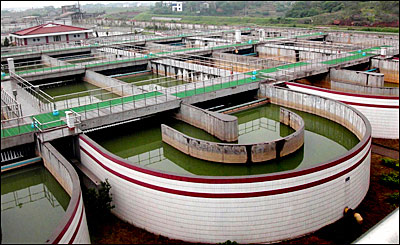| Pollution control |
Environmental quality has seen great improvement thanks to years of
sustained pollution control. In 2004, 41.7 percent of cities recording
air quality reached the national air quality standard of Grade II; the
rate for centralized disposal of urban sewage reached 42.1 percent, for
hazard-free treatment of urban household garbage 58 percent, and for
comprehensive utilization of solid industrial waste 53.5 percent.
According to national plan targets, by the end of 2005, discharge
amounts of main pollutants will be 10 percent less than in 2000. Of
these sulfur dioxide emissions will reduce by 20 percent and the rate of
centralized disposal of urban sewage will reach 45 percent. Pollution
in most areas will be lessened, the environmental quality of key cities
and areas improved and the trend of ecological deterioration curbed. Since 2003, the State Environmental Protection Administration has published an annual update on pollution control in national key river basins and sea areas. Since the Three Gorges Dam started to store water on 10th June 2003, water quality in the reservoir area has not changed much from before. To ensure a safe water environment in the Three Gorges Reservoir Area, the government planned investment of some 40 billion yuan between 2001 and 2010 for control of water pollution in the reservoir area and the upper reaches of the Yangtze River. According to the Plan for Control of Water Pollution in Three Gorges Reservoir Area and the Upper Reaches of the Yangtze River, by the year 2010, water quality at the main control sections in the reservoir area and upper reaches of the river should have met the Grade II standard stipulated in the Environmental Quality Standard for Surface Water, and the eco-environment in the reservoir area should be much improved. The seriously polluted Taihu Lake Basin started to receive a special “infusion” treatment from 2002 -- clean river water was transported from the Yangtze River into this freshwater lake basin covering an area of 36,900 sq km. Since its inception, this project has made a distinct improvement to water environment of the Taihu Lake Basin, benefiting a population of nearly 10 million. The program for prevention and control of water pollution, which started in 2001, planned five years of projects in 1,534 cities, with total investment of 103.63 billion yuan. These included schemes for sewage treatment, control and prevention of water pollution, control and prevention of agricultural and rural pollution, etc. Most of the projects have started, some are already up and running. |

Dedicated Team spirit and thanks to Greenko group CEO and MD Shri Chalamalasetty Sir and Shri Mahesh Koli SIr, AM Green management Shri Gautam Reddy, Shri GVS ANAND, Shri K.Pradeep Shri VIJAY KUMAR (Site Incharge), Shri G.B.Rao, Shri PVSN Raju, Dr. V. Sunny John, Shri V. Parmekar ,Smt .Vani Tulsi,Shri B. B.K Uma Maheswar Rao, Shri T. Govind Babu, Shri P. Rajachand, Shri B.V Rao, Shri. LVV RAO ,Shri P.Srinivaslu Promotion- EHSQL-by Dr. A.N.GIRI- 28.1 Lakhs Viewed Thanks to NFCL.
Friday, 24 August 2012
Pollution control IN CHINA
Subscribe to:
Post Comments (Atom)
Merci de partager cette précieuse information avec notre vision.
ReplyDeletecontrole qualite chine
Blog sympa et son merci très utile pour partager vos informations.
ReplyDeletecontrôle qualité Chine